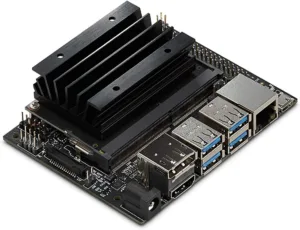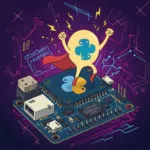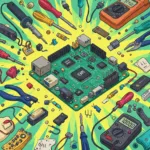The NVIDIA Jetson Nano has become one of the most beloved development boards in the maker and robotics communities — and for good reason. It brings the power of AI to your desk or workbench in a compact, affordable, and energy-efficient form. Whether you’re building a smart robot, experimenting with computer vision, or exploring deep learning at the edge, the Jetson Nano offers an accessible path to start creating with artificial intelligence.

What is the Jetson Nano?
The NVIDIA Jetson Nano is a small, single-board computer developed by NVIDIA, designed specifically for edge AI applications. It stands out by delivering GPU-accelerated performance in a size similar to a Raspberry Pi — but with far more computational punch when it comes to AI tasks.
Jetson Nano is ideal for hobbyists, educators, and researchers who want to prototype AI-powered devices such as:
- Smart security cameras
- Object-detecting robots
- Gesture-recognition systems
- DIY self-driving cars
Tech Specs
Despite its small size, the Jetson Nano packs a powerful combination of CPU and GPU hardware:
- CPU: Quad-core ARM Cortex-A57 @ 1.43 GHz
- GPU: 128-core Maxwell architecture (the same tech used in earlier NVIDIA desktop GPUs)
- Memory: 4 GB LPDDR4 RAM
- Storage: microSD card slot (recommended 16GB+ UHS-1)
- I/O: GPIO, I2C, SPI, UART, USB 3.0, Gigabit Ethernet, HDMI, DisplayPort, and camera interface (CSI)
- Power: 5V 2A via micro-USB or 5V 4A via barrel jack
This hardware allows you to run popular AI frameworks like TensorFlow, PyTorch, and OpenCV, and even deploy trained deep learning models using NVIDIA’s own TensorRT for optimization.
Why the Jetson Nano is Relevant
In an age where AI is moving from the cloud to the edge, the Jetson Nano is more relevant than ever. It offers:
- Real-time AI inference at the edge: Ideal for low-latency applications like robotics and surveillance.
- Energy efficiency: You get high performance without needing a fan or massive power draw.
- Affordability: At under $150, it lowers the barrier for entry into real AI development.
- Educational value: Great for students and makers who want hands-on experience with real-world AI workflows.
Whether you’re a weekend tinkerer or an aspiring roboticist, the Jetson Nano opens the door to creating intelligent systems in your garage, classroom, or lab.
Community and Projects
Although the Jetson Nano has been officially discontinued by NVIDIA, it still has a loyal and active community of developers and makers. While newer models like the Jetson Xavier NX and Orin Nano have taken the spotlight, the Nano continues to be a great platform for learning and prototyping — especially if, like me, you already have one.
I’m currently working on a personal project using my Jetson Nano, exploring what’s still possible with its GPU-accelerated AI capabilities. Despite its age, it holds up well for lightweight computer vision and edge AI experiments.
Some project ideas I’m considering (or experimenting with) include:
- Real-time object detection using a webcam
- A basic home security camera that can recognize people or pets
- An AI-powered smart garden monitor
- A voice-controlled mini-assistant that runs fully offline
Even if the Nano is no longer sold, it still has a lot of life left in it — especially for hobbyists who enjoy squeezing value out of well-built hardware.
My Jetson Projects
Python Upgrade First!
So, you’ve got a Jetson Nano (or another Jetson device) and you’re ready to dive into the exciting world of AI, robotics, and computer vision. But before we get into the fun stuff, the very first thing I tackled was updating Python. Why? Because it’s the foundation for almost everything you’ll do.
Here’s how I approached it (and how you should, too):
- Upgraded Python to 3.10/3.11 — because the old 3.6 version just wasn’t cutting it anymore.
- Set up virtual environments (or Docker if you’re feeling extra lazy) to keep my projects neat and organized.
- Verified everything works smoothly with libraries and packages I’m using for my AI and computer vision tasks.
Once the Python environment was up-to-date and stable, I was free to dive into my projects, which include:
Running LLMs on the Edge
With Python finally up to speed, I jumped into one of the most exciting frontiers, running large language models locally using llama.cpp. The idea of having a conversational AI running on the Jetson itself was too cool to resist.
Here’s what I did to get it running:
- Built llama.cpp from source — compiled it directly on the Jetson with some tweaks for ARM architecture and limited RAM.
- Quantized the model — used 4-bit or 8-bit GGUF files to keep memory usage manageable.
- Served the model via API — fired up the built-in server (
llama-server) to expose a simple REST-like endpoint I could query from other devices. - Tested with real prompts — kept expectations realistic, but was surprised how usable it was for small tasks like summaries or instructions.
Is it blazing fast? No. But it works—and that’s impressive for a device the size of a deck of cards. Perfect for edge AI experiments or low-latency assistants that don’t rely on the cloud.
Software enthusiast with a passion for AI, edge computing, and building intelligent SaaS solutions. Experienced in cloud computing and infrastructure, with a track record of contributing to multiple tech companies in Silicon Valley. Always exploring how emerging technologies can drive real-world impact, from the cloud to the edge.

